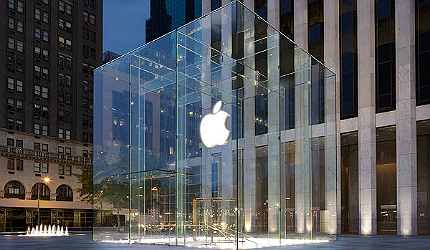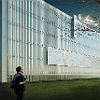
Innovations in Glass Architecture

Glass has been popular for centuries and, thanks to its beauty and elegance as a decorative medium, it somehow seems to maintain an allure of being cutting-edge, fresh and modern. However, it is only in the past ten years that glass has been appreciated for its architectural design strengths.
Rob Cassetti, senior creative services director at the Corning Museum of Glass, explains that glass remains underexplored as a design material, and that’s what makes it so appealing to contemporary artists, designers and engineers.
“What is exciting across the field, in both the decorative arts and in the design fields, as well as in architecture is that new tools are becoming available to better understand what glass can do and there’s a great renaissance of exploration of glass as a material,” says Cassetti.
Once you scratch the surface of what architectural glass could be capable of, it provides designers and engineers with a ‘blank sheet of paper for design exploration’.
Using glass in non-traditional ways
Collaborations across art, design and architecture is making it easier for designers to work with glass makers to make their ideas a reality.

US Tariffs are shifting - will you react or anticipate?
Don’t let policy changes catch you off guard. Stay proactive with real-time data and expert analysis.
By GlobalDataThe Corning Museum of Glass in New York State, US, which is home to a comprehensive collection of glass, actively pursues the idea of allowing individuals from all sectors of the arts and design industry to experiment with glass.
The museum’s GlassLab programme invites designers to bring a sketchbook and explore the material, with glassmakers on hand to realise their concepts in glass.
Using glass in non-traditional ways, as a floor, staircase or even a wall, is seen as contemporary but the original concepts were first presented in the 1920s and 30s. However, collaborations between artists, designers and engineers are finally allowing these ideas to come to life.
“They were conceived almost a century ago but only realised on a practical level in the last decade or so,” Cassetti points out.
Making ideas, reality: developments in architectural glass
There are three key structural developments that have helped to make the ideas of years gone by a reality today: the connector, lamination and structural modelling. First is the idea of a connector, which is a metal part that can be laminated into a glass structure to allow for an attachment point.
“Earlier people would drill through the glass so that [the connector] was a very important breakthrough, like the Louvre Pyramid, for example. That’s how that was put together,” says Cassetti.
The second breakthrough was lamination, as structural glass needs to be laminated with multiple sheets of glass together. Science and innovation company DuPont was a leader in developing interlayer lamination in, most notably, car windscreens.
“The lifecycle of an automobile is very short compared to architecture so there were a lot of technical developments for laminating glass in automobiles for safety and for structure and those technologies have transferred to the world of architecture,” explains Cassetti.
The final development was structural modelling. For an engineer structural design is one of the most important tasks and design begins by developing a structural model. However, thanks to advances in information technology the sections and connections of a design can be detailed using design software computer programmes.
Building codes have also constrained the use of glass in architecture. The building had to stand up on its own with glass added afterwards, unless a case could be argued for glass to be used as a structural element. Rigorous tests, which still take place for big projects, helped architects to defend their case but today glass is increasingly ‘being recognised for its incredible structural capabilities’.
Continued reinvention: speed of change in glass engineering
The Apple Store on Fifth Avenue, New York, is a prime example of a glass structure able to structurally support itself. The 32ft glass cube makes a bold architectural statement as the entrance to the shop, which is hidden underground. The cube houses a transparent glass lift, with a circular glass staircase wrapped around it to take customers to the shop floor below.
Apple’s Fifth Avenue entrance is not only spectacular to look at but it is also illustrates the speed of change and possibilities of glass for engineering and architecture. “It just opened a few years ago and then they completely took the façade off and put a more adventurous façade on it,” says Cassetti.
The original cube, which opened in May 2006, had dozens and dozens of glass pieces. The refurbished one, which was unveiled in November 2011, has three panels of glass on each face and three panels of glass on the roof, so it is made up of only 15 glass pieces.
Similarly, when the Corning Museum of Glass opened its Glass Innovation Center in 1999, the team worked hard to get the biggest jumbo sheet of architectural glass available to put on display.
The jumbo sheet of architectural glass is 10ft 10in wide by 18ft high, but little more than ten years later it looks quite ordinary.”There are Gap stores that I walk by in New York that have sheets of glass bigger than that,” says Cassetti.
Cassetti does not resent how quickly the jumbo has become common place. On the contrary, he believes it demonstrates the beauty of glass. “It’s a story of continued reinvention, continuing to push the boundaries and I think that’s what makes it exciting and that’s why there’s a museum devoted to the subject of glass,” explains Cassetti.
Modern trends: thin and curved glass
Modern reinventions of glass may explain architects current fascination with it and why the Corning Museum of Glass is in the process of adding another wing for its expanding collection.
Related project
Het Glazen Huis (House of Glass), Lommel, Belgium
Brussels-based architect Philippe Samyn won the design competition to build this Centre for Contemporary Glass Art, which opened in the summer of 2006.
The glass façade for the new wing, which is still in development, plans to alter perceptions of glass by creating an almost blurry quality to it. “You may think of glass architecture as very crisp and so the designs we’re looking at now turns the glass at a slightly different angle so it has a softer feel,” Cassetti points out.
The façade is inspired by a piece of artwork in the museum made of ‘broken display glass from flatscreen televisions, which is all glued together but it has an almost, furry, soft look to it’.
Is changing perceptions about glass a new trend? “Absolutely, you can do things with it [glass], even for coatings, you can create thin film coatings on glass that change its reflectivity, just very slightly or very dramatically,” Cassetti explains.
“There are also low ion glasses that are water clear so can really play with extreme transparency and then manipulate the level of reflectivity and because of the different ways you can attach the glass, you can angle it in certain ways.”

Another upcoming trend that Cassetti predicts for the future is curving glass. He explains that although there’s ‘not a lot of built work yet, there’s a lot of exploration into curving glass, not just in the one dimension but in complex forming, such as in the windscreen or windshield of a car and the use of much thinner glasses for architecture’.
Thin glass is completely new, even on the small scale in smartphones and flat screen televisions.
Cassetti believes that when you switch to an architectural scale, where it has barely been explored, it could potentially provide infinite opportunities for designers and engineers alike.
Glass has been known to man for centuries but there is no doubt that the speed of architectural developments during the past ten years has given it a new lease of life. As Cassetti explains: “Glass is a brand new world and a very exciting one to explore from a design perspective”.



